Every year, come October, a relative of ours says, “The festival season has begun.” She goes on to list every single celebration coming up over the next several months. Dussehra/Durga Puja, Govardhan Puja, Karva Chauth, Diwali, Bhai Dooj, and a gazillion smaller festivities, some which I didn’t even know about a few years ago. All the way up to Holi. “And then there’ll be a lull all through the summer and the monsoon,” we’re told, every year.
I don’t know if there’s a definitive answer for the question “Which country has the most festivals in the world?” but I could lay a safe bet that India would be pretty much among the top of the pack. Part of the reason probably is our immense diversity: we have people from widely differing regional cultures here, and following different faiths. As a result, there’s a merry mix of religious festivals, seasonal festivals related to harvest/sowing/etc, as well as secular festivals and celebrations. Some are celebrated pretty much across the country; some are so confined to a particular region that they’re rarely even known of outside that locale.
And these festivals, naturally, show up in Hindi cinema. With, almost invariably, a bonus: a song attached to the festival. After all, a festival is cause for celebration, and what better way to celebrate than with a song?
Therefore, ten ‘festival songs’ (note: I’m not calling these ‘my favourite’; not all of these are especially good). As always, these are from pre-70s Hindi films that I’ve seen (with one exception, a film on the cusp, which feels enough like a late 60s film to merit a place in a 60s list). Also, no two songs are about the same festival.
1. Rang-birangi raakhi lekar (Anpadh, 1962): Rakshabandhan. Along with the romances (and occasional bromances) that feature in Hindi cinema, another popular relationship is that between brother and sister. The brother, ready to lay down his life for his sister, and his sister eager to sacrifice all her happiness in return. Rakhi, Chhoti Bahen, Bhai-Bahen, Aankhen, Anjaana, Hare Rama Hare Krishna… there are many films that had the brother-sister relationship as a vital part of the plot, in some cases even more important than the man-woman romance.
In Anpadh, Mala Sinha’s character is sister to Balraj Sahni, the indulgent elder brother who has brought her up, and been both father and mother to her. Here, in the quintessential rakshabandhan song, she shows her love for her brother, reminding him of their mutual love. All the traditional trappings of the festival are there: the tinseled raakhi tied on his wrist, the tilak on his forehead. The sweets fed to each other, the brother’s gift to his sister. The sister’s promises of eternal love for her veer.
2. Mere bhaiya ko sandesa pahunchaana (Didi, 1959). Bhai Dooj. From the quintessential brother-sister festival to a less well-known one, but still an important celebration. Also known as Bhai Teeka, Bhai Beej (or Bhau Beej), Bhai Phonta, etc, Bhai Dooj follows rituals similar to those of Rakshabandhan, with the sister doing an aarti and tilak for the brother and feeding him while he gives her gifts and vows to protect her.
This one is the only Bhai Dooj song I’ve ever come across in Hindi cinema (or as far as I remember). A lovely song, too: Jayshree’s character plays sister to Sunil Dutt’s character. At Bhai Dooj, the brother and sister cannot meet because he’s too far away and it’s impossible for him to visit. So she entrusts her message to the moon (there’s a significance to this: the moon god, Chandra, is traditionally also worshipped on Bhai Dooj, and if a woman doesn’t have a brother, Chandra stands in for him on Bhai Dooj).
3. Arre jaa re hat natkhat (Navrang, 1959): Holi. Holi is probably the single most popular festival in Hindi cinema. Even more than Diwali, which may be the biggest highlight of the Hindu festival calendar otherwise. Because Holi, with its exuberance and its no-holds-barred rioting of colour and bhaang, lends itself perfectly to a cinema that relies heavily on romance and flirtation for most of its plot. There’s lots of scope for Holi songs, teasing ones and exuberant ones, from Khelo rang hamaare sang to Aaj na chhodenge, from Holi aayi re Kanhaai to… well, dozens of other songs.
Here’s one especially good one, which is also rather unusual. Sandhya enacts a duet, dancing as both Krishna and a gopi (Radha?) on Holi. The gopi tells the mischievous Krishna to be gone; she will curse him, she will not be taken in by him. But the irrepressible Krishna says he doesn’t care; today, on Holi, even her curses will be music to his ears. Sandhya isn’t one of my favourites, but I find her quite mesmerizing in this dance, which is so well choreographed. That tree trunk in the middle acts as a good prop to separate Krishna from the gopi, and later, her costume changes to a form in which, seen from one side, she’s a woman, and seen from the other, a man. The clouds of colour, the pichkaari, the gulaal drifting through the air: Holi, yes, and brilliantly depicted.
4. Govinda aala re aala (Bluffmaster, 1963): Krishna Janmashtami. When it comes to songs, perhaps the one Hindu deity who finds the greatest representation in Hindi cinema is Krishna. Krishna’s gaiety, his raas-leela, his mischief as a butter-stealing toddler, as a matka-phodoing child, and as a flirtatious baansuri-player, makes him a highly popular metaphor for light-hearted pranks and flirtation, both standard elements of romantic plots across Hindi films. Even when a film is otherwise pretty much devoid of any religious connotations, it’s not uncommon to find a song that refers to Krishna as a symbol of love, romance, or mischief.
Not in this case. One of my favourite festival songs, Govinda aala re aala celebrates Krishna Janmashtami, the birthday of Krishna, in a style that does justice to Krishna’s image as a god who likes fun. Shammi Kapoor is in his element as he leads his band of joyous, exuberant Krishna-worshippers through the streets of Bombay to participate in the ceremonial breaking of a dahi handi. Besides the fact that Shammi Kapoor gets totally into the spirit of things, the picturization of the song is worth remarking upon, because this is so obviously the real thing, with hundreds of spectators included in the shots.
5. Kaisi khushi leke aaya chaand Eid ka (Barsaat ki Raat, 1960): Eid. In a cinema that is dominated by Hindu-centric themes, there’s little scope for songs that centre round festivals that belong to religions other than Hinduism. I cannot recall any old songs about Christmas, for instance; or Gurpurab or Budh Purnima… and as for Eid, even in Muslim socials, there are far fewer Eid songs than I would have liked.
But that doesn’t mean there aren’t any. The 1943 film Najma had Eid milo Eid guiyaan, which is a really frothy description of all the joys of Eid, with milk and sweet batashas and sevaiyaan, and of course the joy of celebrating the festival with all one’s loved ones. Eid ke din sab milenge (from Sohni Mahiwal, 1958), on the other hand, is a tragic song about being separated from one’s beloved and therefore unable to enjoy Eid.
This one, therefore, which really is my favourite Eid song. Shyama’s character, all bright-eyed and radiant, celebrates Eid and rejoices that it gives her an excuse to meet the man she’s in love with. Wonderful song, lovely rendition, and while the emphasis is less on Eid and more on romance, still.
6. Sang basanti ang basanti (Raja aur Runk, 1968): Basant Panchami. A festival that has more to do with the cycle of seasons than religion, Basant Panchami is a celebration of spring. In some parts of India (especially in the eastern states of Bengal, Odisha and Assam) it takes the form of Saraswati pooja, the worship of the goddess of learning. In much of Northern India, however, Basant Panchami is less restrained: kites are flown, and many people wear yellow, to symbolize the flowering of mustard, which coincides with Basant Panchami.
Aayi jhoomke basant (Upkaar, 1967) is a song about Basant Panchami; here is another. Sanjeev Kumar, Nazima, and a troupe of highly energetic dancers celebrate Basant Panchami with much verve. There’s a lot of yellow around too, everywhere from turbans to odhnis, pyjamas to artificial flowers.
7. Aayi Diwali aayi kaise ujaale laayi (Khazanchi, 1958): Diwali. Diwali is, at least in Northern India (where I live) by far and away the most popular festival, the very epitome of ‘festival’. The event for which millions of Hindus start preparing well in advance, cleaning homes, buying gifts, decorating homes, and more. Hindi cinema, naturally, also tends to make much of Diwali, though I think there are still more Holi songs than there are Diwali songs.
While there are several Diwali songs that come to mind (including ones that talk of a singer’s loneliness and separation from loved ones, as in Rattan’s Aayi Diwali aayi Diwali or Haqeeqat’s Aayi ab ke saal Diwali, my favourite Diwali song is the lovely Aayi Diwali aayi kaise ujaale laayi. The song, music as well as lyrics and rendition, is wonderful, but it’s made even better by the way the picturization evokes Diwali. Fireworks, sparklers (phuljhadis), diyas, fairy lights… it’s all there, and in abundance. Plus that brief bit where the women, fairy lights outlining them and their sticks, dance while it’s dark all round: a little cheesy, perhaps, but interesting.
8. Aaj hai karva chauth sakhi ri (Bahu Beti, 1965): Karva Chauth. Among the Hindu festivals that have become especially popular onscreen in recent times (by which I mean since the 70s or so), Karva Chauth is one (which says a lot for so-called progress in women’s rights and feminism!) With heroine after heroine gazing up at the moon through a sieve and then turning simperingly to her hero, this is one festival that’s actually begun to make inroads in communities that otherwise never even really celebrated Karva Chauth.
This is the earliest example of a Karva Chauth song that I’ve come across. Mala Sinha and Mumtaz play good friends who get married to cousins and therefore end up living in the same big joint family too. On the day of Karva Chauth, they get together with other women to celebrate the festival, and sing about the significance of the festival, the love and devotion of a wife for her husband. The fact that all these women are dancing so energetically seems a bit far-fetched to me; though I don’t fast myself, I know plenty of women who do, and none of them seem to have this much energy this late in the day.
9. Mera dil jhoom-jhoom gaaye… sabko Happy Christmas (Ek Din Aadhi Raat, 1971): Christmas. Christians, as people other than stereotyped caricatures, are rare in old Hindi cinema. There’s Mrs D’Sa and Anthony Gonsalves, or John Chacha and the many Christian femme fatales Helen played across much of her career, but Christians tend to be either slotted as the villains or the goodie-goodies, nothing in between. Offhand, I can only think of two films (Raat ke Raahi and Baaton Baaton Mein) which were primarily about Christians.
Naturally, then, Christian festivals are rarely noticed onscreen. Even here, in a song ostensibly about Christmas (ostensibly, because it really isn’t), the fact that the song mentions “Sabko Happy Christmas” is incidental. It could just as well have been Happy New Year, or nothing at all. The song is all about romance, the dance is the usual cabaret number, and besides a token Christmas tree (quite lost in all the Egyptian-themed décor of the setting), there’s really nothing to distinguish this as a Christmas song. But that refrain is there, and the tune isn’t bad.
10. De di humein aazaadi bina khadg bina dhaal (Jagriti, 1954): Gandhi Jayanti. And, to end this list, a national festival. Just how much Gandhi Jayanti is actually celebrated on an institutional level was brought home to me forcefully earlier this month, when my seven year old, the ‘Little One’ or LO, because of all the hype at her school, was busy drawing cards with India Gate, Gandhiji and the tricolour; insisted on wearing a churidar-kurta on October 2; and vigorously waved about a tricolour she’d crafted. Plus, since she’d been taught De di humein aazaadi bina khadg bina dhaal by her music teacher at school, she went on singing the first two lines over and over again in a loop… (she couldn’t remember the rest).
So, De di humein aazaadi, which actually plays out in Jaagriti on the occasion of Gandhi Jayanti. There is another Hindi film song about this national festival (Aaj hai do October ka din from the 1968 Parivaar, which celebrates the birthdays of both Mahatma Gandhi and Lal Bahadur Shastri), but I think De di humein aazaadi is far superior as a song: its lyrics, its music, and its rendition are far better.
Which other festivals have been celebrated in song? Please share!


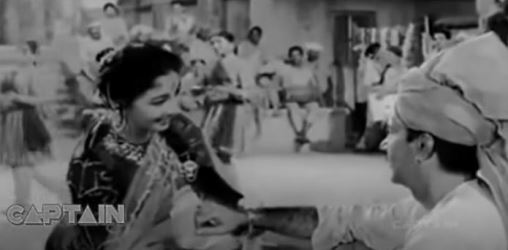

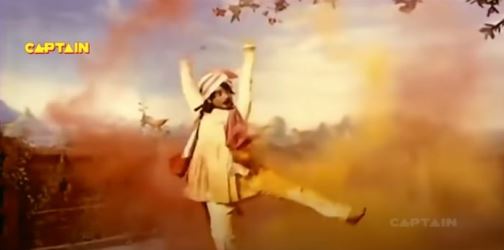
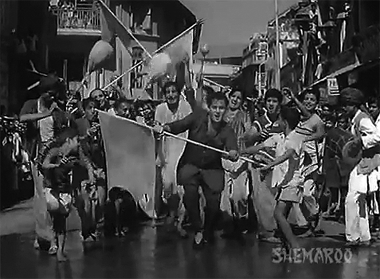
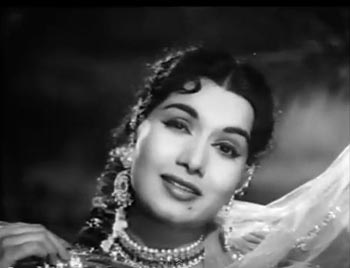
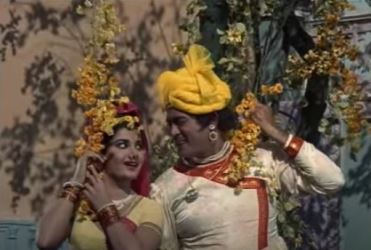
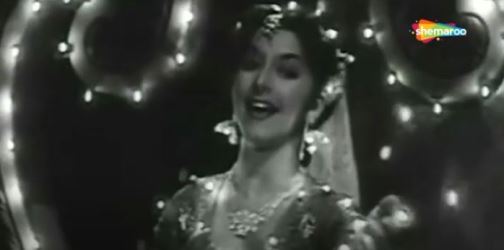

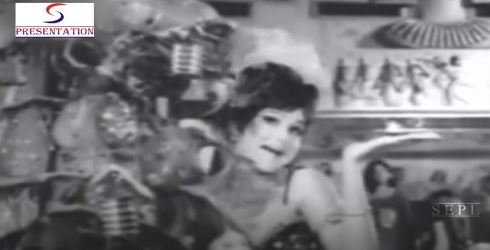
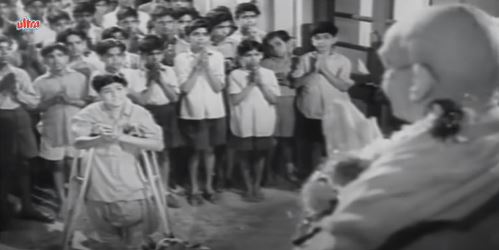
I know I know more relevant songs, but all I can think of is the holi song from Mother India which I do not like and this, which if I understand correctly is a Diwali song or at least is set at Diwali and it has some symbolic significance:
Actually I love this song, such an odd choice to present Govinda as a romantic antagonist, but then he is often presented rather differently than other male actors.
LikeLike
Bol Beliya was new to me, but yes, it’s definitely set during Diwali. Lots of lighting and other Diwali-ish stuff happening!
LikeLike
What a wonderful post! I love the festival season and miss being in India during this time. :-(
Here are 2 festivals that I can think of
Makara Sankranti which is on Jan 14
https://www.youtube.com/watch?v=hTfIvzmp7rs
Ugadi around end of March/April
LikeLike
Ooh, very nice! I was hoping people familiar with non-Hindi films would be able to post songs celebrating festivals from other parts of India too, and you’ve contributed two wonderful songs. I had never heard Sankranti habba or Yuga yugadi kaledaru yugadi before, but have just been listening to them. Lovely.
LikeLike
A good post Madhuji. Liked ans enjoyed it.
Eid ki raat chand layi hai from baghi
I searched for Durga puja song, but got only the suhag 1977 song.
And,
Is there any festival connected with this song from Dooj ka Chand?
I don’t know if any. Someone plz tell.
:-)
LikeLike
Thank you, Anupji, glad you enjoyed this. I liked both songs you’ve posted, though I don’t know if Sajan salona maang lo ji is connected to any festival. Maybe somebody else can confirm.
LikeLike
Thanks for the post. I think the most popular Shiv Ratri song is the one from Munimji – Shivji bihane chale palki sajaye ke. Also a couple of Jai Ganesh Deva songs from the movies Maha Puja and Shri Ganesh Janma in the 50s. I had been looking for holi songs for a celebration at home (some years ago) and was able to find upwards of 50 songs – not so many for diwali, though. Quick note – it is Lal Bahadur Shastri not Ram Bahadur.
LikeLike
I’m glad you enjoyed this, Nishi! Thank you (and for pointing out that gaffe with Shastri – I’ve corrected it. Sometimes I wonder at the way my brain goes to sleep).
I love Shivji bihaane chale, but I wasn’t absolutely sure if it would count as a Shivratri song, which was why I left it out of this list. But it’s a wonderful song, one of my favourites.
50 songs and more for Holi – wow!
LikeLike
I think Shivji Bihaane chase is a Shivratri song in the movie as well..
LikeLike
It’s been so long since I last watched Munimji, I’d completely forgotten.
LikeLike
Lovely post, Madhu. I do miss the festive season in India. In Bombay, it begins with Ganesh Chaturthi and then, it’s one festival after another. I always associate festivals with food. :) :) I wrote a Festivals post way back in 2014 – https://anuradhawarrier.blogspot.com/2014/09/festival-songs.html
We seem to have chosen a few different festivals (just shows how many festivals we do have) – for instance, I didn’t have Bhai Dooj or Karwa Chouth on my list.
So here are a few choices; one that is a happy Eid song from Darwaza (1954)
https://www.youtube.com/watch?v=ls284Sx__Os
Here’s one to celebrate Gujarat’s famed Kite Festival or Uttarayan (Makar Sankranti) when winter fades into summer.
https://www.youtube.com/watch?v=A4g-Wpqe2EM
Then there’s the Mangalagaur festival – a women’s only festival that’s celebrated in Maharashtra. (Here: if you want to read about it – https://tinyurl.com/mangalagaur)
Which Sanjay Leela Bhansali ‘bhansali-fied’ in Bajirao Mastani
And from the South of India, here’s an Onam song, by the honorary Malayali, Salilda. :)
Poovili from Vishukkani
LikeLike
I had forgotten you’d done a Festivals list, Anu – but when I went to your post, I remembered it. Down to remembering which song I’d posted in my comment (and I saw that when I wrote that comment, 7 years ago, I told you that I was toying with a Festival Songs list. Yikes, how slow I am!)
Dekho dekho chaand is a lovely song, and Bajirao Mastani being one of the few newish films I’ve seen, I remember Pinga. :-) Oddly enough, though I’ve seen Hum Dil De Chuke Sanam more than once, I’d forgotten Kaipoche until I began listening to it. A good celebration of the Kite Festival – I liked that a lot.
And a special thank you for Poovili poovili. I’ve heard this before (thanks to you, I think?), and like it a lot.
LikeLike
Madhuji,
An enjoyable post on the occasion of Navratri and upcoming Dussehra with a nice choice of songs related to festivals.
Would like to add Ganesh Chaturthi with two songs from the post-70s:
Deva o deva ganpati deva – Humse Badhkar Kaun (1981)
Deva Shree Ganesha – Agneepath (new) (2012)
And Ram Navmi
Ramji ki nikli sawaari – Sargam (1979)
https://www.youtube.com/watch?v=ZzTFI0KAFV4
Navrarti – Garba
Main to bhool chali babul ka des – Saraswatichandra
LikeLike
Thank you so much for these songs! Two of these (Deva o deva Ganpati deva and Ramji ki nikli sawaari I knew, but didn’t include because they were outside my timeline – so I’m especially happy to see you post them.
LikeLike
Psst, your link for the “Barsaat Ki Raat” song says that the video has been made private, although I was able to find it elsewhere on YouTube.
Thank you for the context regarding the Hindu festivals, which I know of only filtered through films. I know I saw a movie with another Krishna Janmashtami song within the past few months. The details escape me at the moment, but I will link to the song here if I happen to remember which film it was in. It is refreshingly sensible, by the way, to have a “holiday season” that runs from late fall through early spring. In my family’s religion, things fall exactly opposite. You have to prepare so many complex celebrations when the agricultural year is at its busiest and most taxing. Not a good system!
(Also: hi, Popka!)
LikeLike
I’m glad the contexts of the festivals were of interest to you, though I’m not sure I was able to successfully convey those for all the festivals!
“In my family’s religion, things fall exactly opposite. You have to prepare so many complex celebrations when the agricultural year is at its busiest and most taxing.”
Which religion would that be? Sorry to sound so dumb, but… and I do want to know, learning about different cultures (or generally about anything, I’m undiscriminating that way) is something I like a lot.
Regarding the missing video… yup. That happens. This, actually, went offline sometime after I uploaded the post (and rechecked it). That’s why I always make sure I mention the names of all songs, even those people link to in the comments – because video links are here one minute, gone the next, it’s always best to refer to the song, so that people can go search for them even if they’ve gone missing. With hundreds of blog posts now online on this blog, I can’t possibly go updating links every now and then.
LikeLike
It doesn’t sound dumb at all; we belong to a tiny, tiny religion that nobody has heard of ( : We call ourselves “Qaraim” or “Bney Miqra’.” The typical anglicization is “Karaite.” Some people classify it as a heretical variety of Judaism, whereas others just call it one of the “minor” Abrahamic religions like the Druze, Yezidis, Samaritans, etc. It used to be widespread in the Byzantine and Ottoman empires, but for the past few centuries has mostly been confined to Egypt. Then the community started scattering as religious tensions there got worse and worse. The Egyptian government finally kicked the last of them out in 1972; my family wound up in the U.S., where there are 2,000 or so Karaites living.
We actually just had a big holiday last Friday/Saturday. Here is one of the popular Egyptian songs for that day (“Yom Hateru’ah”): https://www.youtube.com/watch?v=KU-mnQ_XzZs I don’t have time to translate the whole thing, but the chorus goes “This is an important day for turning toward god.”
I also remembered which Krishna Janmashtami song I had been trying to think of! It was “Mach Gaya Shor” from “Khud-Daar” (1982): https://www.youtube.com/watch?v=s9aH1y4lttc
This morning I have had the chance to listen to the rest of the songs. I don’t think I have seen this Sandhya actress anywhere before and I am OBSESSED. Obviously, it’s a picturization that demands extra broadness. She is pulling such weird, delightful faces!
LikeLike
Thank you so much for taking the time to explain the Qaraim to me. That was interesting (and also heartbreaking). By the way, belated greetings for that recent festival! I listened to the song you posted, and it gave me gooseflesh, it was so stirring.
Arrrgh. I should have remembered Mach gaya shor – iconic song, that one, and one I like quite a bit, too.
Sandhya was a very successful dancer. Not classically beautiful, I think, but there’s something very arresting about her face – especially because her features are so mobile! She was film maker V Shantaram’s second wife, and acted in several of his films – to be honest, I’m not very sure whether she acted in too many films other than Shantaram’s.
LikeLike
Mainly because of the picturisation, I feel Sar she sarke from Silsila to be a Teej song. There are women on swings and in a garden which makes it so teej like.
I really enjoyed this post, Madhu.
LikeLike
Thank you so much, Ava!
I have to admit I didn’t remember Sar se sarke, but yes, it does look a lot like Teej:
LikeLike
A favourite, this Agomoni song (Aaj Badge) from the Bangla movie Durga Sahoy captures the essence of the Durga Puja so well..
LikeLike
AAJ BAAJE .. not badge :(
LikeLike
And the movie is fairly interesting too.
LikeLike
This was new to me! Thank you so much, Anubha. I loved it. Lovely music and rendition, also great picturization. Very pujo. :-)
LikeLike
I am glad :)
Bangla movies of course have a lot of songs around Pujo… and some very nice ones too.
Getting all nostalgic for the Pandals now. This pandemic has taken its toll on a lot !
Also, if you think appropriate, we can add Sawan’s festive songs here :)
LikeLike
Oh, yes! Sawan’s songs totally fit in here. :-) Here’s Shubho Bijoya, which is absolutely delightful:
LikeLike
awesome !
LikeLike
She’s superb, isn’t she!
LikeLike
There is also Dholi Tharo Dhol Baaje from Hum Dil De Chuke Sanam… the closest to an authentic Garba song in Hindi cinema. There are a few there, but they are more related to the subplot than the festival (e.g: Hey naam re from Suhaag , the Nagada song from Ramleela and of course Main toh bhool chalk babul ka des from Saraswatichandra)
LikeLike
Oh, yes! Thank you. This film was quite a celebration of festivals, now that I think of it. Also that Kaipoche song, which Anu pointed out.
LikeLike
And although this is not a film song (and there are but just a couple of movies in Kashmiri), but there is this lovely old Kashmiri song on Eid, with an equally old film footage.. hence taking the liberty of posting it here.
LikeLike
As you can imagine, I had never heard Eid aayi ras ras. This gave me gooseflesh – it took me back to Kashmir so. Thank you so much, Anubha. Loved this, not just the music and singing but also the refreshingly un-touristy footage.
LikeLike
The number and variety of festivals in India is one of the things I miss most about living in the US. No one seems to celebrate with quite the same exuberance as Desis.:-)
Here are a couple of songs that I think fit the theme.
The first isn’t a particularly great song, but it is definitely a celebration of Christmas so it’ll have to do. :-)
Karo baatein mulakatein aisi raaten…Merry Christmas to You – Bhanwar/Lata-Kishore/RD Burman/Anand Bakshi
And I absolutely love this Basant/Holi song from Angulimaal.
Aayi aayi basanti bela laga re laga – Angulimaal/Lata, Manna Dey, Meena Kapoor/Anil Biswas/Bharat Vyas
LikeLike
I actually don’t mind Karo baatein mulakatein that much, and I’d completely forgotten that it had the ‘Merry Christmas to you’ refrain, so this is a very welcome addition to the list. Thank you, Shalini! And for the song from Angulimaal – this one was new to me. So very Basant Panchami with all that yellow all around!
LikeLike
Amongst Sikhs, prabhat pheris or early morning (prabhat) processions (pheris) are a common way of celebrating occasions like Guru Nanak Jayanti, Guru Gobind Singh’s prakashutsov or Guru Granth Sahib’s prakashutsav. People living in Punjab or small towns or more Sikh dominated areas in places like Delhi (Rajouri Garden et al.) would be more familiar with these. Singing hymns, these pheris would start at one point and culminate at a local or a singh sabha gurudwara. On the way, people would join in the singing, langar stalls would be set up on the road side, garam chai and bread pakodas would be served, little children would accompany the singing with chimtas and khartals. Long ago, when Delhi used to actually get super cold, we would wake up to pitch darkness and run to be a part of these pheris. Our parents would let us run around because it was much safer then, doing seva, eating, singing, cleaning, serving, playing. This song from the punjabi movie, ‘Uccha dar babe Nanak da’ captures those moments very beautifully, I think :-)
https://www.youtube.com/watch?v=HvR7qfpqpYM
In recent times, this title track from Rang de basanti is the only song I can think of which, well at least the images seem to indiacte, cover the hola mohalla celebrations. They coincide with holi and are a celebration of the coming of spring.
Then there is this, from a Punjabi movie called Sajjan Singh Rangroot (it is about the Sikh regiment that fought for the British in the battle of Gallipoli during WW1). This is baisakhi celebration in the trenches.
LikeLike
Thank you so much for these songs, Simrita, and for your reminiscences of the prabhat pheri. I really got goose flesh listening to these (on a side note, someone on my Facebook network commented the other day that it’s such a pity Sikh devotional music is so little-known in Hindi cinema, given that it’s crowded with really beautiful hymns).
I must mention my own memory of a prabhat pheri. :-) When we lived in Delhi a few years ago, a gurudwara was very close to our home, and in the festive season, they would take out prabhat pheris. I remember waking up very early one morning, well before dawn, because the singing group was passing by in front of our home. The LO was a baby – I think just over a year old – and used to sleep in her bassinet in our room. Both my husband and I woke up, worried that she too would have been disturbed. But what do we see? The LO was standing up in her bassinet, dancing for all she was worth to the sound of the music from outside. She was in seventh heaven!
LikeLike
Madhu,
This is an excellent post. I am sure a deep research would yield some more festival songs. Let me mention two which are missing so far.
1. ‘Santoshi Mata’: No one had heard of this deity, nor any festival associated with her. But ‘Jai Santoshi Ma’ changed all that. Her temples came up here and there. Fridays got associated with her. On that day eating pickles or any sour thing was prohibited. There was no public festival to my knowledge. But many devout ladies started observing some rituals on Fridays.
2. ‘Mata ki chowki’: One can go to Vaishno Devi or any Devi-sthan to ‘Chalo bulawa aya hai, Mata ne bulaya hai’. But some people set up ‘Mata ki chowki’ or ‘Mata ka darbar’ or ‘Mata ka jagaran’ during Navratri as a community festival. Many current singers have grown from being Jagaran singers. This can be treated as a festival, with devotional songs for ‘Mata’ on filmy tunes. You know better than to object to all-night high decibel songs.
AK
LikeLike
Thank you, AK, both for the appreciation as well as for that insight into the Mata ki Chowki and the rituals surrounding Santoshi Mata. I remember watching Jai Santoshi Mata years ago on Doordarshan, when I was a child (and far more forgiving in my cinema-viewing!) – and finding it simply painful.
“You know better than to object to all-night high decibel songs.”
I know! When we lived in Delhi, there were several temples very close to our home, and they used to be really loud. Plus there used to be all these jaagrans, it was really tiresome. But my husband is very intolerant of such things, and not scared about countering them either – so he actually filed a complaint with the local police station, and managed to get all the jaagran crowd to take down their loudspeakers. :-)
LikeLike
Madhu,
Hats off to your husband. Most of us prefer discretion. Some festivals are very unruly. The kaanwariyas take the cake. If they ever cross your path, you have to only pray to Lord Shiva that your car does not touch them. That can also treated be a festival – Bol Bum!
AK
LikeLike
Oh, yes! The kaanwariyas are a holy terror.
LikeLike
Madhuji, here is a song celebrating Easter from the movie Amar Akbar Anthony – My name is Anthony https://www.youtube.com/watch?v=wlxfIIgKZho&t=91s. There is Amitabh emerging from the Easter egg!
LikeLike
Hmm. I’m not so sure about My name is Anthiny Gonsalves. While the setting is an Easter party, there’s not a single line in the lyrics about it being Easter. Not even a perfunctory “Happy Easter” – so I would not actually put that as an Easter song.
LikeLike
There is they song on Baisakhi, Jatta aaayi Baisakhi from Iman Dharm
LikeLike
And I see that you just mentioned it too DO !!
LikeLike
I mentioned it, and right after, I removed it! :-D Because when I actually started watching it, I was no longer sure if the ‘baisakhi’ they were referring to was the festival or crutches, given that all of them onstage had crutches. Do you know? It may just be a pun, of course, that they’re celebrating a joyous Baisakhi despite being hampered by baisakhis.
LikeLike
There is also this lovely Lohri song from Shaheed , Jogi hum toh lut gaye tere pyaar main..
I couldn’t find a video online so here is the link to the movie online .
https://www.youtube.com/watch?v=9k6-3XlAU7s
The song appears at approximately 31:40 Mts.
LikeLike
I had forgotten that this song was a Lohri one! Lovely addition to the list, thank you. :-)
LikeLike
There is also this Lohri song from Veer Zara
LikeLike
The song, unfortunately , is not worth much !
LikeLike
Yes, not a nice song. But it does fit the Lohri theme!
LikeLike
Cringe worthy (if I remember the movie a bit), but this song seems to be around the Vat Savitri Pooja Festival..
Deepak mere suhaag ka … from Maang Bharo Sajna
LikeLike
I don’t think I ever watched this film. The title itself sounds cringeworthy!
LikeLike
What a collection of songs!!
Did not know so many festivals were covered in songs.
The one that quickly comes to mind is ‘Holi ayee Holi ayee’ from Mashaal. The movie is based on famous Marathi play ‘Ashrunchi Zali Phule’ which gave phenomenon called Kashinath Ghanekar to Marathi industry. His was the character which Anil Kapoor played in the movie. The song is remake of Marathi popular song ‘Jambhul pickalya zadakhali’ from another famous movie ‘Jait re Jait’.
Another typical Maharashtrian festival is ‘Waari’. As per Hindu calendar in month of Aashadh and Kartik, on Ekadashi, people visit Pandharpur Vitthal Mandir. Some of these people are visiting this temple for generations and they walk for days to reach Pandharpur carrying palanquins of late saints. They are called warkaris and most of them are farmers. Majority of their work is done before waari is started and so the tradition continues till date. This spirit is beautifully captured in ‘Mauli Mauli’ song by Ajay Atul. It was depicted in a tableau of Maharashtra on Republic Day parade some years ago and it won best tableau award that year. The video shows actual footage of Waari.
Ajay Atul has explored rustic and lesser known forms of music in mainstream Marathi cinema. Another such form is ‘Gondhal’ which is carried out during Navratri( mostly Ashtami and/or for major life events like Marriage, Grihapravesh)
Another version of it is Jogwa which is also carried out for Godess but it is carried out by Devdaasis. Thankfully this tradition is getting diminished. Here is a ‘Lallati Bhangar ’ song from National Award winner movie ‘Jogwa’
Another coastal maharashtrian festival is Narali Poornima happens on or a day before Raksha Bandhan. Fisher folk start fishing again on this day which is stopped due to Monsoon. They dance, offer coconut (hence name Narali) and pray to seas for safety of their loved ones on this day. This one only slightly mentions Punav(Poornima) but considered a classic.
Somebody mentioned MangalaGaur in reference to ‘Pinga’ song from Bajirao Mastani. It is celebrated on Shravan Tuesday, newly married womanfolk pray to Gauri(Parvati) and keep awake whole night playing games, singing songs and carry out Uttar Puja next morning. Pinga is one such game played. Two of authentic MangalaGaur songs are
https://youtu.be/-yo73GHbc3g
https://youtu.be/ALACtRus1w4
I am sorry if I am heavy on Marathi songs here but could not find anything similar in Hindi which can give an idea of these festivals.
So I will end with a Ghoomar which is danced on Gangaur festival in Rajasthan if I am not wrong. Though this Padmavat song does not specify Gangaur, it is still a ghoomer hence worthy of mention.
LikeLike
This is a real treasure trove! Thank you so much. I’m glad you included those Marathi songs, because they really help showcase festivities unknown to most people outside Maharashtra. Also many thanks for the ghoomar dance. Beautiful!
LikeLike
I am glad you loved the songs I listed.
One of song for Krishna Janmashtami I would love to see here is ‘Mohe panghat pe’
It actually starts with midnight celebrations and then break into song and dance.
There are lot of cringe worthy Vat Savitri Hindi and marathi songs. A sweet one is from movie Sati Savitri I have not watched movie and I don’t see any video available. Since lyrics fit the bill, I would like to add
LikeLike
Jeevan dor tumhi sang baandhi was new to me, thank you for this! I had forgotten, too, that Mohe panghat pe Nandlal has a Janmashtami connect. Yes, of course! I still remember that scene with Durga Khote and the little golden jhoola, if I remember correctly, on which the idol of Krishna was placed.
LikeLike